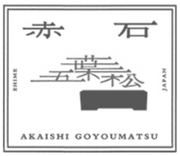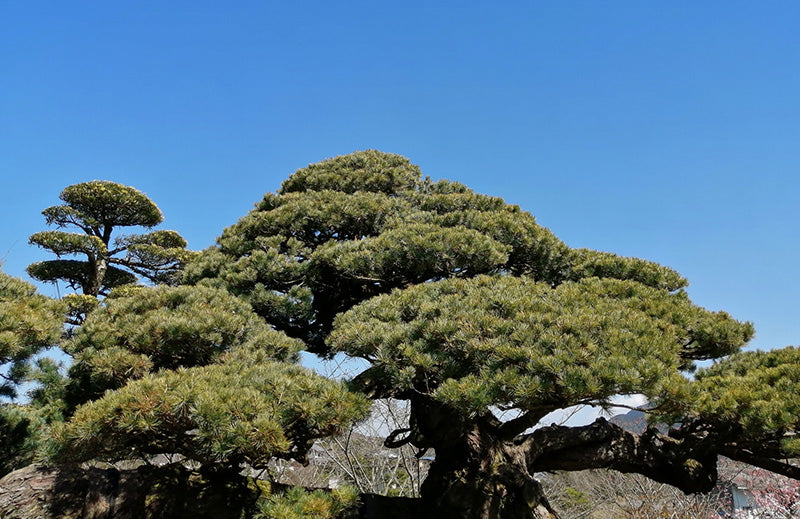Classification and Characteristics of the Three Major Production Areas

There are two main types of pine trees: the southern (Southern Pinus densiflora) and the northern (Northern Pinus densiflora). The southern type grows in Shikoku and Chugoku regions, while the northern type grows mainly in the Tohoku region.
Within the two species, there are further differences in foliage and bark depending on where they grow.
The famous Shikoku Goyo (from Shikoku), the Nasu Goyo (from Mt. Nasu), and the Azuma Goyo (from the Azuma mountain range in Fukushima Prefecture) are the three best known types of Goyo Pine in Japan.
There are also Miyajima Goyo, Alpine Goyo, Zao Goyo, and Asama Goyo.
Shikoku Goyo
From the Meiji Era to the Taisho Era and the early Showa Era, the mountains of Shikoku have provided the bonsai world with many excellent materials. Shikoku Goyo is the general name for Goyomatsu that grow in the subalpine zone of the Ishizuchi mountain range, the highest mountain in western Japan. They can be roughly divided into two groups: the Akaishi and Ishizuchi mountain ranges.
In general, the Akaishi lineage is the best known of the five leaf pines because of its good shape and short leaves.
The leaves of the Akaishi series are thicker and less fragrant, and it is designated as a natural monument by Ehime Prefecture, while the leaves of the Ishizuchiyama series are softer and more feminine.
Because of overharvesting in the past, the species is systematically harvested by licensed local seed collectors, and the material is thoroughly selected and cultivated by the Akaishi Goyomatsu Bonsai Association.
The old-growth forests of Japanese Goyomatsu that still exist today are the fruit of the passionate efforts of our ancestors to protect the material and regenerate it into bonsai.
Among the Shikoku Goyomatsu, there are two main types of bonsai because of the differences in the way they are made.
Takamatsu Bonsai

Bonsai produced in the Kinashi and Kokubunji towns of Takamatsu City, Kagawa Prefecture, are known as Takamatsu Bonsai. Takamatsu Bonsai's Goyomatsu is created using the techniques of "grafting" and " screw trunk" in order to create a bonsai-like trunk surface and tree shape in a few short years from a seedling.
In grafting, a fast-growing Black Pine is grafted onto a fast-growing Goyomatsu to make the slow-growing five-leaf pine grow faster.
Screw trunks are made by wrapping a wire around the trunk, which bites into the tree as it grows, giving the trunk a rough appearance and encouraging the tree to grow stronger against the wire, creating the appearance of an old tree in a short period of time.
This technique was developed by Takamatsu craftsmen with the idea of "making" trees; bonsai finished with pruning and wire trimming are also dynamic and have a sense of being "made" and are the royal road to bonsai.
Akaishi Goyomatsu

Akaishi Goyomatsu, produced in Shikokuchuo City, Ehime Prefecture, is characterized by its seedling Goyomatsu, which is grown from seeds over a long period of time.
Many of the bonsai are not grafted or screwed, but are created naturally over the years. The shape of the tree is characterized by a gentle tex =ture that makes the most of its natural form.
It is interesting to note that there are so many differences between the same Shikoku Goyomatsu depending on the craftsman of the region.
Nasu Goyo

The Nasu Goyo is found in the Nasu mountain range that straddles Tochigi and Fukushima prefectures. It is centered on the foot of the main peak, Chausu-dake, and along the ridges to Asahidake and Akamenzan in the north, and to Minamigetsuzan, Hakusasazan, and Kuroodani-dake in the south.
The native trees have a variety of leaf and skin characteristics. The leaves are short and bright green in color, and only the Nasu Goyomatsu is described as "standing."
The Nasu Goyomatsu is distinguished from the creeping Goyomatsu by the fact that its branches and stems grow upright, and the leaves are less lush.
Azuma Goyo (Fukushima Goyo)

Distributed around the Azuma mountain range in Fukushima Prefecture, centering on Azuma and Adachi Taro mountains. The mountains surrounding Fukushima have long been known as a treasure trove of five-leaf pine trees, and even today it is a place where many native trees can be seen as samples of bonsai forms.
Among the Azuma mountain range, the area from Kamanuma to Hiraishiyama and Isai-Kyozan is considered to have both good foliage and skin.
At altitudes below 1,000 meters, the leaves are often thin, the trees are vigorous and the trunks tend to be thick, but the wood is soft and the age of the trunk surface seems to be difficult to bear.
There is a tendency to have a large number of both leaves and buds, but there are many materials with a variety of characteristics.


